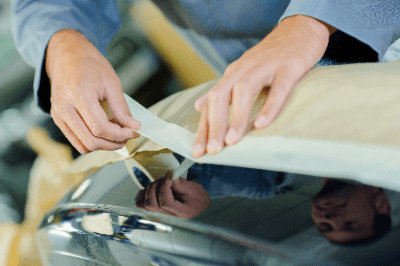What Is Masking Tape?
 Masking tape, commonly used for “covering” or “wrapping,” is mainly utilized in metal surface treatment. It is categorized into two types based on application: for painting and electroplating.
Masking tape, commonly used for “covering” or “wrapping,” is mainly utilized in metal surface treatment. It is categorized into two types based on application: for painting and electroplating.
Masking tape for painting, used in spraying or brushing paint, requires specific properties like adhesion, peeling ease, solvent resistance, and prevention of discoloration or contamination. Crepe paper adhesive tape, known for its elongation and flexibility, is preferred for high-quality finishes in industries like aircraft and automotive, particularly for masking curved surfaces.
For electroplating, masking tape mainly protects base terminals from plating solutions. It necessitates properties such as chemical resistance, heat resistance, and adaptability to various metal surfaces. American masking materials, like vinyl tape, polyester tape, lead hack tape, aluminum hack tape, and solid wax from Michigan Chrome & Chemical Co., serve as typical examples.
Uses of Masking Tapes
Beyond painting and electroplating, masking tapes find applications in the construction industry for sealing and flooring protection. Paper-based masking tapes are gaining popularity in households and the art field due to their clean removability, writability, and diverse colors. The “mt art project” by Kamoi Kakoshi Co., Ltd. has played a significant role in popularizing tape art globally.
Principle of Masking Tapes
Masking tapes originated from adhesive tape. In 1874, Robert Wood Johnson began producing adhesive bandages using natural rubber, enhanced with pine resin and vegetable fillers for stickiness at room temperature. Later, the founding of Johnson & Johnson in 1886 led to the introduction of chemical-free bandages, widely used as surgical tape.
This background paved the way for the evolution of black tape, a precursor to electrical insulation tape, and eventually to masking tapes. In 1920, medical tape was adapted for car body painting. The automotive boom in Detroit, USA, saw a significant sale of Johnson & Johnson’s medical tape. However, as it wasn’t designed for masking, challenges like paint seepage arose.
In 1925, R.G. Drew of the Minnesota Mining and Manufacturing Company (now 3M) developed an improved masking tape. This tape could adhere to various surfaces at room temperature or with finger pressure and be removed cleanly, addressing issues like layer cracking or feathering through the incorporation of crepe paper with Japanese crepe.